The Small Molecule-Drug Conjugates Market is estimated to be valued at USD 1.4 billion in 2025 and is projected to reach USD 6.5 billion by 2035, registering a compound annual growth rate (CAGR) of 16.6% over the forecast period.
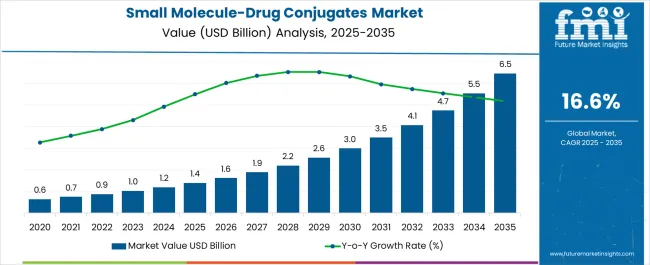
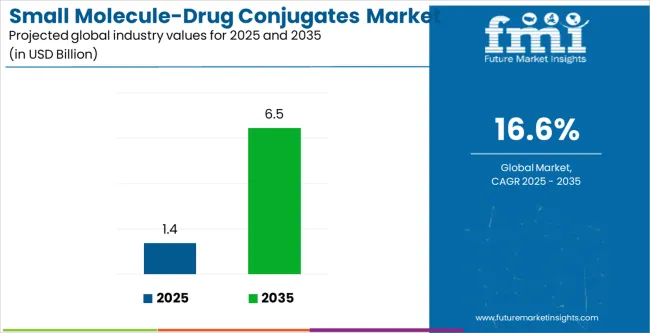
| Metric | Value |
|---|---|
| Small Molecule-Drug Conjugates Market Estimated Value in (2025 E) | USD 1.4 billion |
| Small Molecule-Drug Conjugates Market Forecast Value in (2035 F) | USD 6.5 billion |
| Forecast CAGR (2025 to 2035) | 16.6% |
The small molecule drug conjugates market is gaining traction due to their ability to deliver targeted therapeutic outcomes with reduced systemic toxicity. Rising prevalence of chronic diseases and the need for precise drug delivery platforms have accelerated the adoption of these therapies.
Advancements in linker technologies, payload design, and conjugation chemistry have improved stability and efficacy, supporting broader clinical application. Pharmaceutical companies are actively investing in research collaborations and clinical trials to expand the therapeutic pipeline, particularly in oncology and autoimmune disorders.
Regulatory support for accelerated approval pathways and rising investment in precision medicine are further bolstering market momentum. The future outlook remains strong as innovation in drug conjugates aligns with the growing demand for more effective and safer treatment modalities.
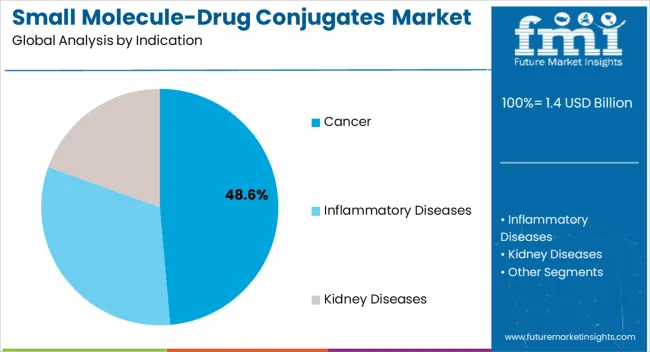
The cancer indication segment is projected to account for 48.60% of total revenue by 2025, making it the dominant segment within the indication category. Growth in this segment is being driven by the urgent need for effective targeted therapies in oncology, where traditional chemotherapies often result in significant side effects.
Small molecule drug conjugates provide enhanced tumor targeting while minimizing damage to healthy tissues, thereby improving patient outcomes. Rising cancer incidence worldwide, combined with increased investments in oncology research and the expansion of clinical trials, has reinforced adoption in this segment.
The ability to combine potent cytotoxic agents with targeted delivery mechanisms has positioned cancer as the leading indication driving the small molecule drug conjugates market.
Global small molecule-drug conjugates market has led to the development of several promising drug candidates that are in various stages of clinical trials.
Growing emphasis on precision medicine and targeted therapies, have led many companies to enter into research and development activities within SMDC industry. SMDCs are likely to offer a unique advantage by delivering drugs directly to the desired site of action. This targeted approach has the potential to improve treatment outcomes and minimize off-target effects.
Looking ahead, the global small molecule-drug conjugates industry is expected to rise at a CAGR of 17.5% from 2029 to 2035. During the forecast period, the market size is expected to reach USD 6.5 Billion by 2035.
The small molecule-drug conjugates industry is expected to continue its growth trajectory from 2025 to 2035, driven by increasing technological advancements and oncology dominance. SMDCs has the potential to selectively deliver potent drugs to cancer cells, leading to improved treatment outcomes and reduced side effects. The focus on targeted therapies for different types of cancers is likely to contribute to market expansion over the forecast period.
SMDCs have the potential to deliver targeted therapies based on individual patient characteristics, such as genetic profiles or biomarkers. This approach will allow for more precise and effective treatment strategies, leading to market growth.
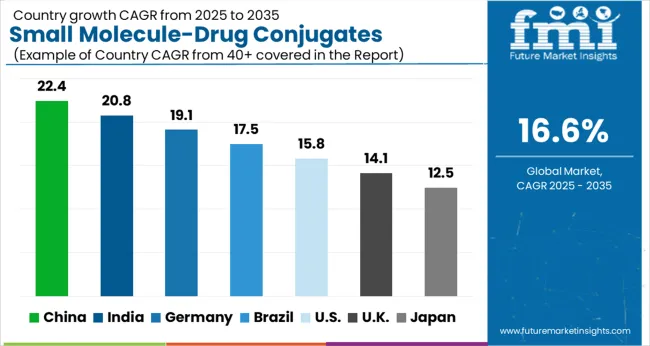
| Country | The United States |
|---|---|
| Market Size (USD billion) by End of Forecast Period (2035) | USD 6.5 billion |
| CAGR % 2029 to End of Forecast (2035) | 19.5% |
The small molecule-drug conjugates industry in the United States is expected to reach a market size of USD 6.5 billion by 2035, expanding at a CAGR of 19.5%. Targeted therapies have gained significant attention in the treatment of various diseases, including cancer.
SMDCs offer the opportunity to deliver small molecule drugs specifically to diseased cells or tissues, minimizing systemic exposure and reducing off-target effects. The focus on personalized medicine and precision therapies in the United States is likely to drive the development of SMDCs to achieve targeted and more effective treatment outcomes.
| Country | The United Kingdom |
|---|---|
| Market Size (USD million) by End of Forecast Period (2035) | USD 518.3 million |
| CAGR % 2029 to End of Forecast (2035) | 15.3% |
The small molecule-drug conjugates industry in the United Kingdom is expected to reach a market share of USD 518.3 million, expanding at a CAGR of 15.3% during the forecast period. The National Health Service (NHS) in the UK plays a significant role in healthcare and innovation.
The NHS actively supports the adoption and implementation of innovative therapies, including targeted therapies like SMDCs. The NHS provides a platform for clinical trials, patient access, and evaluation of novel therapies, enabling the development and uptake of SMDCs.
| Country | China |
|---|---|
| Market Size (USD million) by End of Forecast Period (2035) | USD 149.6 million |
| CAGR % 2029 to End of Forecast (2035) | 16.3% |
The small molecule-drug conjugates industry in China is anticipated to reach a market size of USD 149.6 million, moving at a CAGR of 16.3% during the forecast period. China has implemented regulatory reforms to streamline the drug approval process and encourage innovation. The National Medical Products Administration (NMPA) has introduced expedited pathways for the evaluation and approval of innovative therapies, including targeted therapies like SMDCs. The regulatory reforms facilitate the translation of SMDCs from preclinical studies to clinical trials and market approval.
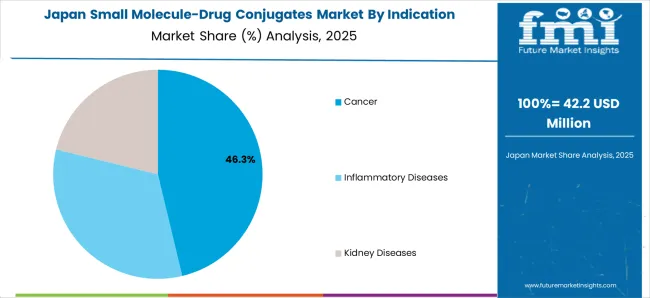
| Country | Japan |
|---|---|
| Market Size (USD million) by End of Forecast Period (2035) | USD 138.7 million |
| CAGR % 2029 to End of Forecast (2035) | 15.8% |
The small molecule-drug conjugates industry in Japan is estimated to reach a market size of USD 138.7 million by 2035, thriving at a CAGR of 15.8%. Japan is known for its technological expertise, including drug discovery and development technologies. Advanced technologies, such as drug delivery systems and conjugation techniques, are harnessed in the development of SMDCs. Japanese researchers and companies have contributed significantly to advancements in drug delivery and targeting strategies, supporting the development of SMDCs.
| Country | South Korea |
|---|---|
| Market Size (USD million) by End of Forecast Period (2035) | USD 113.1 million |
| CAGR % 2029 to End of Forecast (2035) | 11.2% |
The small molecule-drug conjugates industry in South Korea is expected to reach a market size of USD 113.1 million, expanding at a CAGR of 11.2% during the forecast period. Immunotherapy has revolutionized cancer treatment, and South Korea is actively pursuing advancements in immuno-oncology. SMDCs can be designed to enhance the efficacy of immunotherapeutic agents by delivering small molecule drugs to immune cells or the tumor microenvironment. The development of SMDCs for immuno-oncology applications is a promising trend in South Korea.
The cancer is expected to dominate the small molecule-drug conjugates industry with a CAGR of 18.1% from 2029 to 2035 owed to high prevalence of cancer and growing demand for targeted therapies.
Small molecule-drug conjugates allow targeted delivery of small molecule drugs to cancer cells. By conjugating small molecule drugs to targeting moieties such as anti-bodies or ligands specific to cancer cells surface markers, SMDC’s can selectively bind to cancer cells, increasing drug accumulation at tumor site while minimizing exposure to healthy cells. This targeted delivery approach will enhance the therapeutic efficacy & reduces off-target side effects. Thus, expected to be contributing as the leading share-holder by 2029.
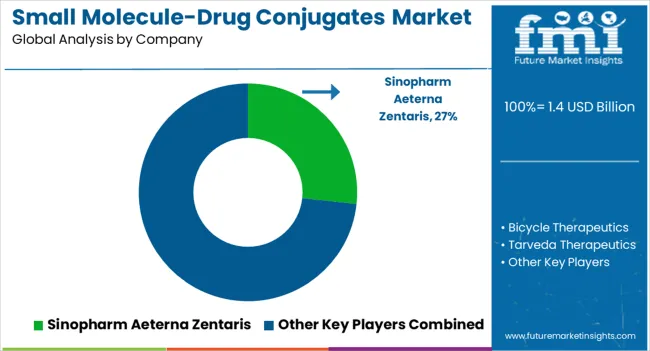
The small molecule-drug conjugates market is fiercely competitive, with many companies trying to capture the market by speeding up their drug approval process and be the market leader.
Key Strategies Used by the Participants
Product Development
Companies are investing heavily in research and development to deliver novel products that improve efficiency, dependability, and cost-effectiveness. Product innovation allows businesses to differentiate themselves from their competition while also catering to the changing demands of their clients.
Strategic Alliances & Collaborations
Key industry leaders frequently develop strategic partnerships and collaborations with other companies in order to harness their strengths and increase their market reach. Companies might also gain access to new technology and markets through such agreements.
Expansion into Emerging Markets
The small molecule-drug conjugates market is expanding rapidly in emerging regions such as China and India. Key firms are enhancing their distribution networks and developing local manufacturing facilities to increase their presence in these areas as soon as their products are released into the market.
Acquisitions and mergers
Mergers and acquisitions are frequently used by key players in the small molecule-drug conjugates business to consolidate their market position, extend their product range, and gain access to new markets.
Pharmaceutical companies are investing heavily in the research and development of drugs and have recognized the potential market opportunities. This has led to the development of several promising drug candidates that are in various stages of clinical trials.
Key Developments in the Small molecule-drug conjugates Market:
The global small molecule-drug conjugates market is estimated to be valued at USD 1.4 billion in 2025.
The market size for the small molecule-drug conjugates market is projected to reach USD 6.5 billion by 2035.
The small molecule-drug conjugates market is expected to grow at a 16.6% CAGR between 2025 and 2035.
The key product types in small molecule-drug conjugates market are cancer, _endometrial cancer, _esophageal cancer, _non-small cell lung cancer, _solid tumor, _bone metastasis, _others, inflammatory diseases and kidney diseases.
In terms of , segment to command 0.0% share in the small molecule-drug conjugates market in 2025.






Full Research Suite comprises of:
Market outlook & trends analysis
Interviews & case studies
Strategic recommendations
Vendor profiles & capabilities analysis
5-year forecasts
8 regions and 60+ country-level data splits
Market segment data splits
12 months of continuous data updates
DELIVERED AS:
PDF EXCEL ONLINE
Small Gas Engine Market Size and Share Forecast Outlook 2025 to 2035
Small Molecule CDMO Market Size and Share Forecast Outlook 2025 to 2035
Small Molecule CMO/CDMO Market Size and Share Forecast Outlook 2025 to 2035
Small Animal Metabolic Monitoring System Market Size and Share Forecast Outlook 2025 to 2035
Small Animal Running Wheel System Market Size and Share Forecast Outlook 2025 to 2035
Small Caliber Ammunition Market Size and Share Forecast Outlook 2025 to 2035
Small Boats Market Size and Share Forecast Outlook 2025 to 2035
Small Capacity Electrolyzer Market Size and Share Forecast Outlook 2025 to 2035
Small Animal Imaging (In Vivo) Market Size and Share Forecast Outlook 2025 to 2035
Small Cell Lung Cancer (SCLC) Treatment Market Size and Share Forecast Outlook 2025 to 2035
Small Molecule Innovator CDMO Market Size and Share Forecast Outlook 2025 to 2035
Small Cell Network Market Size and Share Forecast Outlook 2025 to 2035
Small Wind Turbine Market Size and Share Forecast Outlook 2025 to 2035
Small Satellite Market by Ticketing Infrastructure, by Orbit Type, by Application & Region Forecast till 2035
Small Off-Road Engines Market Size and Share Forecast Outlook 2025 to 2035
Small Continuous Fryer Market Size and Share Forecast Outlook 2025 to 2035
Small Molecule Inhibitors Market Analysis – Size, Share, and Forecast Outlook 2025 to 2035
Small Signal Transistor Market Size and Share Forecast Outlook 2025 to 2035
Small Bowel Enteroscopes Market Size and Share Forecast Outlook 2025 to 2035
Small Paint Pail Market Size and Share Forecast Outlook 2025 to 2035

Thank you!
You will receive an email from our Business Development Manager. Please be sure to check your SPAM/JUNK folder too.
Chat With
MaRIA